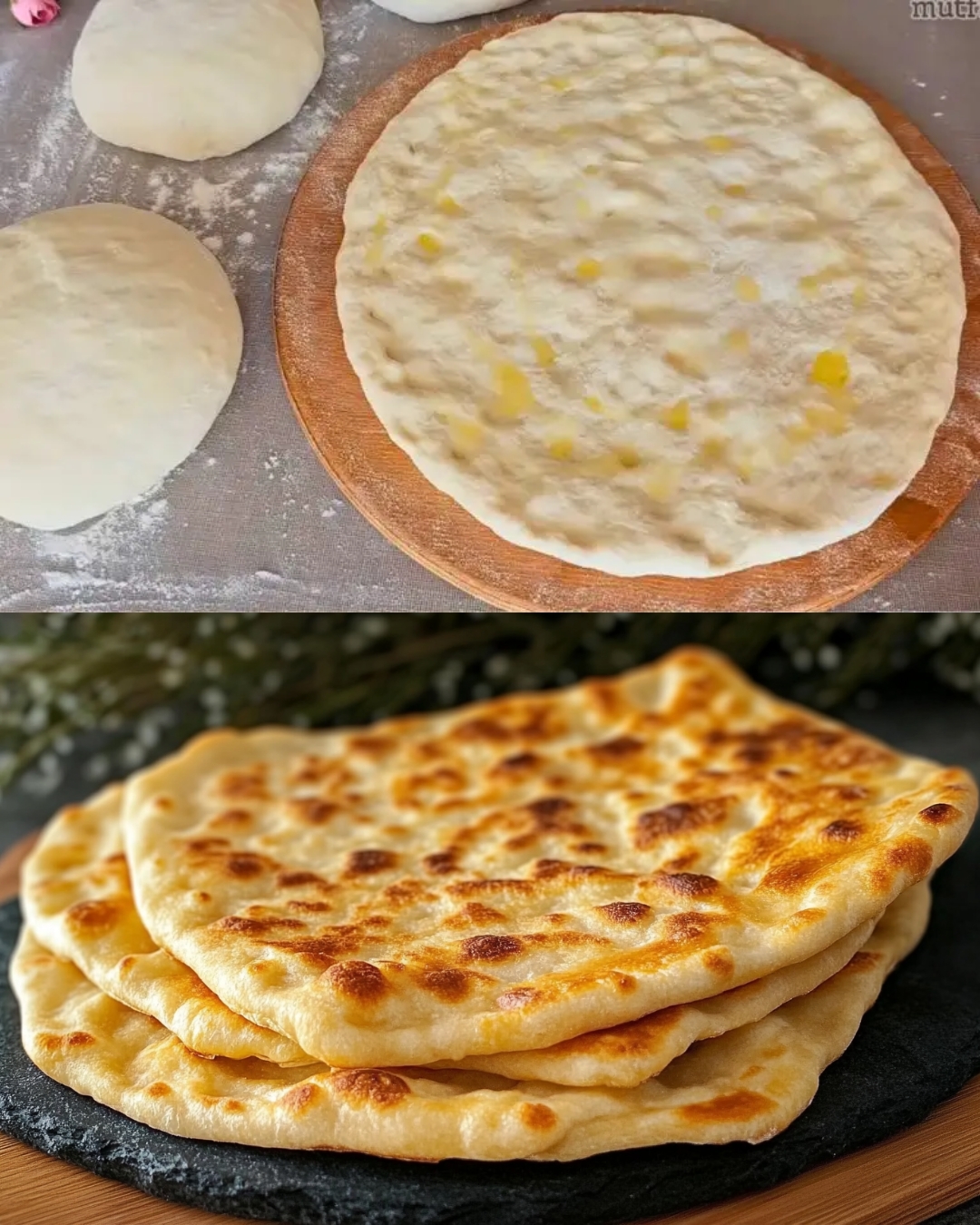Turkish flatbread, or “lavaş,” is a soft and delicious bread traditionally baked in a tandoor oven. This homemade version is perfect for serving with kebabs, dips, or as a wrap for various fillings. The dough is simple to make, and the bread comes out soft, slightly chewy, and wonderfully warm. It’s great for family meals or casual gatherings!
Preparation Time: 15 minutes
Resting Time: 1 hour
Cooking Time: 3-4 minutes per bread
Total Time: 1 hour 30 minutes
Servings: 6 flatbreads
Ingredients:
- 500g (4 cups) all-purpose flour
- 1 teaspoon salt
- 1 teaspoon sugar
- 7g (2 teaspoons) active dry yeast
- 2 tablespoons olive oil
- 300ml (1 1/4 cups) warm water
- 1 tablespoon yogurt (optional, for extra softness)
- Extra flour for rolling
Directions:
- Prepare the Dough:
- In a large mixing bowl, combine the flour, salt, and sugar. Make a well in the center.
- Dissolve the yeast in warm water and let it sit for 5 minutes until frothy.
- Add the yeast mixture, olive oil, and yogurt (if using) into the flour mixture. Stir until a dough forms.
- Knead the dough on a lightly floured surface for about 8-10 minutes, until it’s smooth and elastic.
- Place the dough in a lightly oiled bowl, cover with a clean kitchen towel, and let it rise in a warm place for about 1 hour, or until doubled in size.
- Shape the Flatbreads:
- Preheat a large skillet or griddle over medium-high heat. If you have a tandoor or clay oven, that’s even better!
- Punch down the dough and divide it into 6 equal portions. Roll each portion into a ball.
- On a lightly floured surface, roll each ball into a thin circle or oval shape (about 1/8 inch thick).
- If you want, you can use a rolling pin to gently flatten the dough, or stretch it by hand to achieve a rustic look.
- Cook the Flatbreads:
- Place each rolled-out dough onto the hot, dry skillet. Cook for 2-3 minutes on each side, or until the bread puffs up and gets golden brown spots.
- You can press gently with a cloth or spatula to help the bread puff evenly.
- If desired, brush the flatbreads with a little melted butter or olive oil after cooking.
- Serve:
- Serve the Turkish flatbreads warm with your favorite dips, kebabs, or use them to make wraps.
Serving Suggestions:
- Serve with hummus, tzatziki, or baba ganoush.
- Wrap around grilled meats, veggies, or falafel for a sandwich.
- Use as a side to your favorite Turkish or Middle Eastern stews.
- Enjoy with cheese and olives for a simple snack.
- Use to scoop up soups, curries, or lentil dishes.
Cooking Tips:
- Make sure the skillet or griddle is hot enough before placing the dough on it. The high heat ensures that the flatbread cooks quickly and puffs up.
- Don’t overwork the dough; let it rest to achieve a soft texture.
- You can brush the flatbread with olive oil or melted butter for extra flavor after cooking.
Nutritional Benefits:
- Rich in carbohydrates for energy.
- Contains healthy fats if olive oil is used.
- Can be a good source of fiber if using whole wheat flour.
- Provides protein if served with protein-rich fillings like meat or legumes.
Dietary Information:
- Vegetarian (can be made vegan by omitting yogurt).
- Dairy-free (if yogurt is omitted).
- Nut-free.
Nutritional Facts (per flatbread):
- Calories: 150-180 kcal
- Carbs: 30g
- Protein: 4g
- Fat: 3-5g
- Fiber: 1g
- Sodium: 200mg
Storage:
- Store leftovers in an airtight container at room temperature for up to 2 days.
- To keep them soft, wrap in a kitchen towel or plastic wrap.
- For longer storage, freeze the flatbreads. Just reheat them in the oven or on a skillet when ready to serve.
Why You’ll Love This Recipe:
- Quick and easy to make with simple ingredients.
- Soft, chewy texture that complements a variety of dishes.
- A versatile bread that can be served with everything from dips to grilled meats.
- Perfect for meal prep—make a batch ahead and store for the week.
Conclusion: Turkish flatbread is a versatile and delicious addition to your cooking repertoire. It’s perfect for wrapping around meats, veggies, or simply enjoying with your favorite dips. The dough is easy to make, and the end result is warm, soft bread that everyone will love. Make it for your next meal and enjoy the taste of Turkish cuisine at home!
Frequently Asked Questions (FAQs):
- Can I make Turkish flatbread with whole wheat flour?
- Yes, you can substitute whole wheat flour for a more rustic, fiber-rich bread. The texture will be slightly denser.
- How long can I store Turkish flatbread?
- Store it in an airtight container at room temperature for up to 2 days, or freeze for up to 3 months.
- Can I use a regular oven to bake Turkish flatbread?
- You can bake the bread in a preheated oven at 220°C (425°F) on a baking sheet for about 5-7 minutes, but it won’t puff as much as when cooked on a hot griddle.
- Can I make Turkish flatbread without yogurt?
- Yes, the recipe can be made without yogurt, especially if you want to keep it dairy-free.
- How do I make Turkish flatbread without yeast?
- You can try using baking powder as a substitute, but the texture will be slightly different.
- Can I use a tandoor or clay oven for this recipe?
- Yes, a tandoor or clay oven gives the bread an authentic flavor and texture, making it even better.
- Can I add herbs or garlic to the dough?
- Yes! You can add chopped fresh herbs like parsley, thyme, or garlic for extra flavor.
- Is Turkish flatbread gluten-free?
- Traditional Turkish flatbread is made with wheat flour and is not gluten-free. However, you can use a gluten-free flour blend as a substitute.
- How do I reheat leftover flatbread?
- Reheat flatbread in a hot skillet or oven for a few minutes until warm.
- Can I use this recipe to make pizza crust?
- Yes, this dough can work as a quick and easy pizza crust. Just add your favorite toppings and bake for 10-12 minutes.

